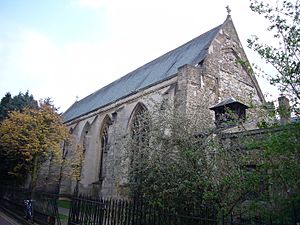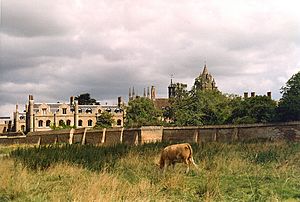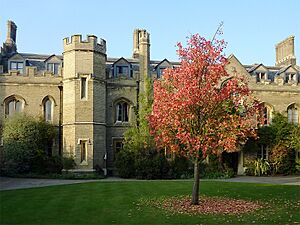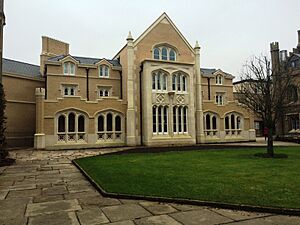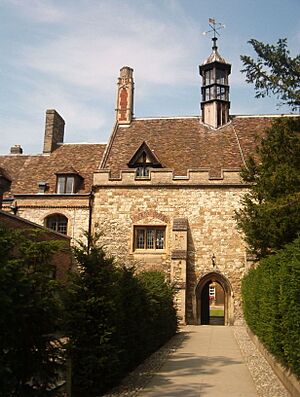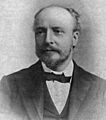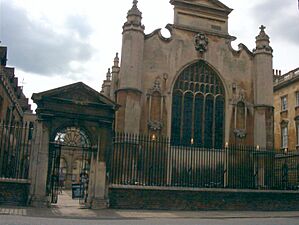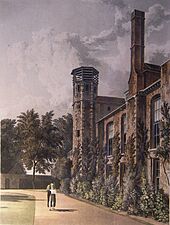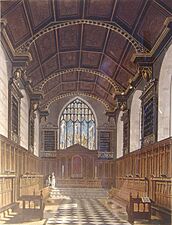Peterhouse, Cambridge facts for kids
Quick facts for kids Peterhouse |
|||||
|---|---|---|---|---|---|

Old Court, facing the Chapel
|
|||||
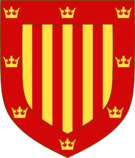
Arms of Peterhouse
Blazon: Or four pallets Gules within a border of the last charged with eight ducal coronets of the first |
|||||
|
|
|||||
| University | University of Cambridge | ||||
| Location | Trumpington Street (map) | ||||
| Full name | The Master (or Keeper) and Fellows of Peterhouse in the University of Cambridge | ||||
| Abbreviation | PET | ||||
| Founder | Hugh de Balsham, Bishop of Ely | ||||
| Established | 1284 | ||||
| Named after | Peter the Apostle | ||||
| Previous names |
|
||||
| Sister colleges | Merton College, Oxford | ||||
| Master | Professor Andy Parker | ||||
| Undergraduates | 290 (2022–23) | ||||
| Postgraduates | 187 (2022–23) | ||||
| Map | |||||
| Lua error in Module:Location_map at line 420: attempt to index field 'wikibase' (a nil value). | |||||
Peterhouse is the oldest college at the University of Cambridge in England. It was founded in 1284 by Hugh de Balsham, who was the Bishop of Ely. Peterhouse is home to about 300 undergraduate students and 175 graduate students. It also has 54 fellows, who are like senior teachers and researchers. People sometimes mistakenly call it Peterhouse College, but its correct name is simply Peterhouse.
Many famous people have studied at Peterhouse, especially in science. These include scientists like Lord Kelvin, Henry Cavendish, Charles Babbage, and James Clerk Maxwell. Five Nobel prize winners in science also studied here: Sir John Kendrew, Sir Aaron Klug, Archer Martin, Max Perutz, and Michael Levitt. Other notable alumni include the Archbishop of Canterbury John Whitgift, film director Sam Mendes, and comedian David Mitchell. Even two Prime Ministers, Augustus FitzRoy, 3rd Duke of Grafton from Britain and Elijah Mudenda from Zambia, attended Peterhouse.
Peterhouse is one of the richest colleges in Cambridge. It has assets worth over £320 million. The college encourages its students to eat together at communal dinners called "Hall". There are two sittings for Hall. The second one is called "Formal Hall". It's a special three-course meal by candlelight. Students must wear suits and gowns. During Formal Hall, students stand when the fellows enter. A gong rings, and two Latin prayers are read. Peterhouse also hosts a big formal ball every two years as part of the May Week celebrations.
In recent years, Peterhouse has been one of the top-performing colleges in Cambridge. Its academic results can change each year because it has a smaller number of students. However, it has been in the top ten of the 29 colleges in the Tompkins Table for the past five years. Peterhouse was ranked fourth in both 2018 and 2019.
Contents
History of Peterhouse
How Peterhouse Started
Peterhouse began in 1280. King Edward I allowed Hugh de Balsham to keep scholars at the Hospital of St John. These scholars were meant to live by the rules of Merton College, Oxford. But the scholars and the hospital staff didn't get along. So, in 1284, Balsham moved the scholars to the college's current location. He bought two houses near Trumpington Gate for a Master and fourteen "worthy but impoverished Fellows." The scholars used the nearby Church of St Peter without Trumpington Gate as their church. Bishop Hugo de Balsham died in 1286. He left money that was used to buy more land. The college's main dining hall was built on this new land.
The first official rules for the college were given in 1344 by Bishop Simon Montacute. These rules helped the college, which didn't have many resources back then. In 1401, the college gained more wealth. This was thanks to Bishop John Fordham and John Newton. During the time of Queen Elizabeth I, the college also got more land. This land is now where the William Stone Building stands.
From the 16th Century Onwards
In 1553, Andrew Perne became the Master. He was very adaptable in his religious views. Both Queen Mary I and Queen Elizabeth I liked him. There was a joke that the letters on the church weathervane could mean "Andrew Perne, Papist" or "Andrew Perne, Protestant." It depended on which way the wind blew. Perne left a lot of money to the college when he died in 1589. This money helped fund scholarships. He also left a large collection of books. This collection is now called the Perne Library.
Between 1626 and 1634, Matthew Wren was the Master. He was the uncle of the famous architect Christopher Wren. Matthew Wren strongly supported Archbishop William Laud. Under Wren, Peterhouse became known for its Arminian beliefs. This continued when John Cosin became Master in 1634. Cosin made big changes to the college's Chapel. He wanted it to match Laud's idea of "beauty of holiness." In 1643, during the English Civil War, Cosin was removed from his position. Later that year, statues and decorations in the Chapel were destroyed.
Peterhouse was the first college at the University to have electric lighting. Lord Kelvin installed it in the Hall and Combination Room. This was to celebrate the college's 600th anniversary in 1883–1884. It was only the second building in the entire country to get electric lighting. The first was the Palace of Westminster.
The college became very strong in teaching history. This was especially true during World War II. At that time, four history professors taught there.
Peterhouse Today
In the 1980s, Peterhouse became linked with Conservative politics. Some influential fellows, like Maurice Cowling and Roger Scruton, were part of this. They were sometimes called the "Peterhouse right." This group was connected to Margaret Thatcher. Conservative politicians Michael Portillo and Michael Howard also studied at Peterhouse. During this time, the college admitted women students in 1983. This was a big change. Today, Peterhouse has a more modern and welcoming reputation.
Buildings and Grounds
Peterhouse is located on Trumpington Street in Cambridge. It's just south of the Fitzwilliam Museum. The college buildings are very old and have been changed many times. The college was partly destroyed by fire in 1420. The main entrance has also moved over the years. Today, the entrance faces Trumpington Street.
First Court
The area closest to Trumpington Street is called First Court. The Burrough's Building is to the north. The Porters' lodge is to the south. The Chapel is to the west. Above the Porters' lodge is the Perne Library. It was built in 1590 for the books donated by Andrew Perne. Electric lighting was added to the library in 1937.
Burrough's Building
The Burrough's Building is at the front of the college. It was built in 1736 by Sir James Burrough. He was the Master of Caius. This building is one of several Palladian style buildings he designed in Cambridge. Fellows and college offices use this building.
Old Court
Old Court is behind the Chapel cloisters. The dining hall is on the south side. It is the only college building that remains from the 13th century. Between 1866 and 1870, the hall was restored. Its timber roof was fixed. Stained glass windows by William Morris and Edward Burne-Jones were added. The fireplace was also restored with tiles by Morris. The hall was updated again in 2006-7.
The north and west sides of Old Court were built in the 15th century. They were updated in the 18th century. The Chapel forms the east side of the court. Students and fellows live in Old Court. The college's MCR (Middle Combination Room) is also on the north side.
Chapel
The Chapel is the most visible building from Trumpington Street. It was built in 1628. Before this, the college used the nearby Church of St Mary the Less. The Chapel was officially opened on March 17, 1632. Its style mixes Renaissance details with traditional Gothic design. The Chapel has a Pietà altarpiece and a ceiling with golden suns. Its location in the middle of a court is unique.
The original stained glass was destroyed in 1643. Only the east window's crucifixion scene survived. The current side windows were added in 1855. The cloisters on each side of the Chapel are from the 17th century. The Chapel Choir is small but famous for performing old church music. The organ in the Chapel was restored by Noel Mander.
Gisborne Court
Gisborne Court is accessed through an archway from Old Court. It was built in 1825-6. The money came from a gift by Rev. Francis Gisborne. It is built in white brick in a simple Gothic revival style. Only three sides were built at first. The fourth side was a screen wall, which was removed in 1939. Most rooms in Gisborne Court are for undergraduate students. Many famous alumni, like Lord Kelvin, lived here.
Whittle Building
The Whittle Building opened in 2015. It is named after Frank Whittle, who invented the jet engine. This building has modern student rooms with private bathrooms. It also has the student bar, a common room, and a gym. Its design looks like the old screen-wall that was once there. In 2015, it was nominated for the Carbuncle Cup. This award is for the "ugliest building" in the UK.
Fen Court
Fen Court is beyond Gisborne Court. It's a 20th-century building, partly on stilts. It was built between 1939 and 1941. It was one of the first buildings in Cambridge designed in the Modern Movement style. A carved panel above the entrance has a special message. It says "DE PROFUNDIS CLAMAVI MCMXL" (out of the depths have I cried out 1940). This is from Psalm 130. It also shows St Peter being saved from the sea.
Ward Library
The Ward Library is in the north-west corner of the college site. It is housed in old Victorian warehouses. This building used to be the University's Museum of Classical Archaeology. It was changed into a library in 1982 and opened in 1984. A new reading room, called the Gunn Gallery, was added recently.
Gardens
The area south of Gisborne Court is called the Grove. But it's been known as the Deer Park since deer were brought there in the 19th century. It was once famous as the smallest deer park in England. However, the deer got sick after World War I, and there are no longer any deer there.
The college also has other gardens. The Fellows' Garden is south of Old Court. The Scholars' Garden is at the south end of the site. It surrounds the William Stone Building.
William Stone Building
The William Stone Building is in the Scholars' Garden. It was built with money from William Stone, a former student. It is an eight-storey brick tower. It houses fellows and undergraduate students. The rooms have been updated to include private bathrooms.
Trumpington Street Buildings
Peterhouse also uses several buildings on Trumpington Street.
Master's Lodge
The Master's Lodge is across Trumpington Street from the college. It was given to the college in 1727. It is a red brick building in the Queen Anne style.
The Hostel
The Hostel is next to the Master's Lodge. It was built in 1926 in a neo-Georgian style. It was meant to be part of a larger complex, but only one part was built. It provides housing for undergraduate students and some fellows. During World War II, the London School of Economics used this building.
Cosin Court
Cosin Court is behind The Hostel. It has accommodation for fellows and graduate students. It is named after John Cosin, a former Master of Peterhouse.
St Peter's Terrace
This is a row of Georgian townhouses. First-year undergraduate students, fellows, and some graduate students live here. It is right in front of the William Stone Building.
College Arms
The college has used five different coats of arms over its history. The current one has two accepted designs. The first was granted in 1575. It shows:
- Or four pallets Gules within a border of the last charged with eight ducal coronets of the first.
However, the college often used a version with three pallets. This was allowed in 1684. The version with three pallets was officially adopted in 1935. The design combines the arms of the founder, Hugo de Balsham, with the crowns of the See of Ely.
College Grace
| Latin | English |
|---|---|
|
Benedic nos Domine, et dona Tua, quae de Tua largitate sumus sumpturi, et concede, ut illis salubriter nutriti, Tibi debitum obsequium praestare valeamus, per Christum Dominum nostrum, Amen. Deus est caritas, et qui manet in caritate in Deo manet, et Deus in eo: sit Deus in nobis, et nos maneamus in ipso. Amen. |
Bless us, O Lord, and Thy gifts, which of Thy bounty we are about to receive, and grant that, fed wholesomely upon them, we may be able to offer due service unto Thee, through Christ our Lord, Amen.
God is love; and he that dwelleth in love dwelleth in God, and God in him: let God be in us, and let us remain in the same. Amen. |
Peterhouse and Jesus College are the only two colleges with two parts to their grace. The first part is a standard prayer. The second part is a quote from 1 John 4:16 in the Bible.
People from Peterhouse
People who have been Masters, fellows, or students at Peterhouse are called Petreans.
-
John Whitgift
Archbishop of Canterbury -
The Duke of Grafton
Prime Minister of Great Britain -
Thomas Gray
Poet -
Edward Law, 1st Baron Ellenborough
Lord Chief Justice -
Charles Babbage
Inventor of the difference engine, known as the "Father of the computer" -
Henry Cavendish
Scientist, discoverer of hydrogen -
Sir James Dewar
Chemist, physicist, inventor of the Dewar flask -
Lord Kelvin
Inventor and pioneer in thermodynamics, electricity and telegraphy -
James Clerk Maxwell
Developed classical electromagnetic theory -
Sir Frank Whittle
Inventor of the jet engine -
Niall Ferguson
Historian -
Michael Portillo
Broadcaster and former politician -
Colin Greenwood
Bassist for Radiohead -
James Mason
Actor -
Roger Scruton
Philosopher -
Sam Mendes
Film and stage director
Nobel Prize Winners
Five Nobel Prize winners have been connected with Peterhouse. They were either students or fellows.
- John Kendrew – Won the Nobel Prize in Chemistry (1962). He helped figure out the first atomic structures of proteins using X-ray crystallography.
- Sir Aaron Klug – Won the Nobel Prize in Chemistry (1982). He developed crystallographic electron microscopy.
- Michael Levitt – Won the Nobel Prize in Chemistry (2013). He developed models for complex chemical systems.
- Archer Martin – Won the Nobel Prize in Chemistry (1952). He invented partition chromatography.
- Max Perutz – Won the Nobel Prize in Chemistry (1962). He also helped figure out the first atomic structures of proteins using X-ray crystallography.
Gallery
See also
 In Spanish: Peterhouse para niños
In Spanish: Peterhouse para niños
- Master of Peterhouse, Cambridge
- List of organ scholars
- The Chaplin Society


